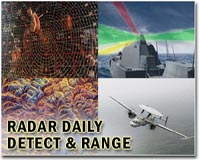 |
Santa Cruz, Calif. (UPI) Feb 18, 2011 A U.S. scientist says using storm-chasing radars to follow swarms of bats as they emerge at night is advancing a new scientific discipline dubbed "aeroecology." Researchers coined the term to describe the interactions of organisms -- birds, bats and insects -- in the lower atmosphere. Aeroecology can be recognized as a stand-alone discipline just as marine biology is recognized as a stand-alone discipline concerning life in the oceans, Winifred F. Frick, an environmental researcher at the University of California, Santa Cruz, said. "It's very interdisciplinary or transdisciplinary in the sense that it involves bird biologists and bat ecologists, entomologists, radar scientists and meteorologists," she said. Radar images of bats appear as distinct "blooms" of radar reflectivity and give scientists clues to their behavior, Frick said. Frick and other researchers have used truck-mounted radars as well as data from 160 fixed radars around the country, familiar as "Doppler radar" in television weather reports, to track bat behavior, a UCSC release said Friday. The researchers say the opportunity to look back through recorded radar data from the last two decades can reveal information about population changes among bats, insects and migrating birds.
Share This Article With Planet Earth
Related Links Space Technology News - Applications and Research
 Canada upgrades air defense radars
Canada upgrades air defense radarsOttawa (UPI) Jan 27, 2011 Canada has announced plans to upgrade and modernize a pair of military radar systems in a bid to boost the defense of North American airspace. In announcing the move, Defense Minister Peter MacKay said the new portable tactical radar systems for the Canadian military in Alberta and Quebec are part of an $80 million project upgrading the country's air force The project also includ ... read more |
|
| The content herein, unless otherwise known to be public domain, are Copyright 1995-2010 - SpaceDaily. AFP and UPI Wire Stories are copyright Agence France-Presse and United Press International. ESA Portal Reports are copyright European Space Agency. All NASA sourced material is public domain. Additional copyrights may apply in whole or part to other bona fide parties. Advertising does not imply endorsement,agreement or approval of any opinions, statements or information provided by SpaceDaily on any Web page published or hosted by SpaceDaily. Privacy Statement |